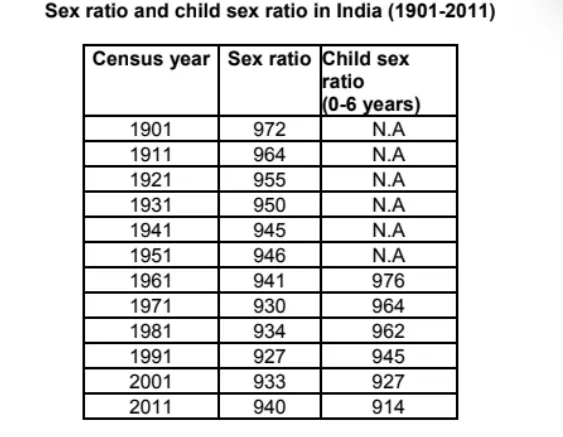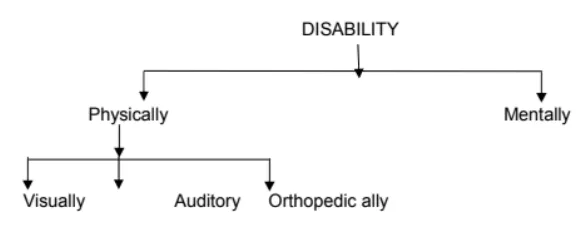
Concept Of Disparity 1
1) Write a short note on violence against women.
Answers : United Nations Declaration 1993, defined violence against women as “any act of gender base violence that results in or is likely to result in physical, psychological or sexual harm or suffering to a woman, including threats of such acts, coercion or arbitrary deprivation of liberty, whether occurring in public or private life”. This is an all inclusive definition of VAW.
a) The violence of her basic human rights often takes place in various ways. It may take a form of sex determination and sex selective abortion, neglect of infant and girl child in the areas of nutrition healthcare, illiteracy and drop outs, under estimation of household work, inequality and harassment at the work place, dowry and related harassments including bride burning, sexual assault, rape, religious rituals, cultural practices, misrepresentation in media and many others.
b) According to the National Crime Records Bureau’s facts :
i) Every three minutes there is a crime against women
ii) Molestation happens every 15minutes
iii) Sexual harassment every 53minutes
iv) 4 out of 10 women in India face violence in their homes.
c) Form of violence against women :
Violence against women can be classified broadly into three categories…
i) Domestic violence :
The violence which takes place within the household or by a known perpetrator is considered to be domestic violence. Wife beating, wife battering, dowry harassment, emotional torture by family members, sexual abuse, marital rape( sexual intercourse which is non-consensual in nature), deprivation of basic necessities, discrimination in the family and denial of economic rights are all a part of domestic violence.
ii) Criminal violence :
The act which are considered to be crime and punishable under Indian Penal Code termed as criminal violence. They are Rape, molestation, trafficking of women, sexual harassment at work place, bride burning, abduction and kidnapping, eve teasing, female foeticide or infanticide are all part of Criminal Violence.
iii) Social violence :
The violence which women face due to societal norms and religious practices are part of social violence. It includes Sati, prohibition of widow remarriage, child marriage, devdasi, denial of entering or worshipping at religious places, atrocities against woman in the name of caste, community etc.
2) Differentiate between sex ratio and child sex ratio. Review the problem of declining sex ratio in India.
Answers : Sex ratio is calculated as the number of females per thousand of males. Sex ratio of any country is not just a demographic variable but an important indicator of country’s gender development index. And an adverse sex ratio reveals a lopsided social development and violation of human rights. India is one of those female deficit countries in the world where sex ratio is calculated per thousand of males. In most of the developed nations sex ratio is always calculated as number of males per thousand of females as there is a natural tendency of female foetus to survive longer than their male counter parts.
A) Sex ratio in India has seen a declining trend since the turn of the century. The sex ratio, which was 972 per 1000 of men in 1901, has declined to 933 in 2001. It has marginally increased to 940 in the year 2011. There is also a concept of child sex ratio that is calculating the sex ratio is in the age group of 0-6 years which is also declining drastically in India. From 976 in 1961 to 927 in 2001 and as per the provisional census report for 2011 it has further declined to a devastating 914. (See table).

The sharp decline in the sex ratio is not evenly distributed in the country as well. Economically affluent states and literate areas have lower sex ratio compared to tribal and illiterate areas where sex ratio is much better. Urban areas are far more behind than rural areas. States like Punjab, Haryana and Rajasthan are historically female deficit states and continue to be so.
B) Problem of declining sex ratio in India :
i) Female infanticide and foeticide – Several Indian states historically were known for its practice of female infanticide. With
the idea of girl child being a burden to the family, there was a rampant elimination of female infants thorough various practices
like ‘doodh piti’ (drowning in milk) in Gujarat, suffocating the child, consumption of opium seeds etc. After the new reproductive
technologies were available the heinous practice shifted from infanticide to foeticde.
ii) Sex Determination (SD) and Sex Selective Abortion (SSA) – With the introduction of new reproductive technologies in 1970s in India, amniocentesis and ultrasound sonography was a big hit amongst the doctors and families expecting a child. Apart from knowing the abnormalities in the foetus, this technology also revealed the sex of the child which helped the parents to determine the sex and abort an unwanted female foetus. This is considered to be the major reason for declining sex ratio.
iii) Dowry and burden of marriage cost – Dowry is the gifts in terms of cash or kind given by the bride’s parents to the groom’s family. The high demands of dowry converts girl into a liability for her parents and marrying her to a suitable groom becomes a burden. With increasing cost of marriages, which are forced to be borne by the bride’s family alone and ever increasing evil of dowry practice are the root cause for considering a girl child in the family as a commodity to be disposed through infanticide or foeticide to avoid the financial burden later.
3) Discuss disability as a form of inequality with reference to mental disability.
Answers : An inability to efficiently cope up with the day to day activity can be referred as disability. It is impairment may it be physical, mental, cognitive, sensory or emotional restricting individual in its daily routine. Generally disability is often replaced by the use of the term handicapped or challenged. But disability has a more affirmative connotation and does not cripple individual’s acceptance in the society in terms of opportunities. There are also terms used like differently able than disabled especially in terms of mental disability. We are broadly classifying the disabled as physical and mental disability.

A) Physical disability- visual, auditory and orthopedic :
A person who is unable to perform normal physical activity in the day to day life due to some impairment is called physically disabled. It is further divided into three types based on the deformity in a particular organ. Those with deformity of vision are called blind or visually disabled. Individuals with problem of speech and hearing come under the category of auditory disabled or deaf and dumb.
B) Mental disability- Levels and types of mental disability:
When a person looses the capacity to think independently and rationally, whose intellectual levels are not developed then the person is called mentally disabled. Individuals with an intelligent quotient (IQ) of less than 70 can be considered as a mentally retarded or mentally disabled. Levels of mental retardation: On the basis of the IQ levels of an individual the mental retardation is analyzed at four different levels.
1) Mild mental retardation- An individual whose IQ is between 50- 70 is called mild mentally retarded. These children can complete their primary level of education comfortably but have problems of concentration and analytical ability is also verylow.
2) Moderate mental retardation- Individual with an IQ between 35-50 is called moderate mentally retarded. They can’t take up formal education and needs support of their family members to do their daily chores. They can be made independent with some basic technical skills and can be made self reliant in their own health and safety.
3) Severe mental retardation- Persons with an IQ of 20-35 are severely mentally retarded. Their learning ability is very limited and need close supervision and support of a family member in their daily lives.
4) Profound mental retardation- Individual with an IQ lower than 20 are profound mentally retarded. They can’t be kept at home and need intensive treatment at an asylum or mental hospital.
Treatment:
Psychological counseling, behavioral therapy, occupational therapy can all help the patient to lead a normal like. Special schools and shelter homes provide them skills in art, handicrafts or other technical skills that enable them to be self sufficient and confident. Training in social adjustment through skills for safety, security and hygiene make them more acceptable and adaptable in the family and society.
4) Classify the category of physically disabled.
Answers : A person who is unable to perform normal physical activity in the day to day life due to some impairment is called physically disabled. It is further divided into three types based on the deformity in a particular organ. Those with deformity of vision are called blind or visually disabled. Malnutrition, ignorance and inefficient medical faculties are major causes for physical disability in our country.
A) Visual disability:
A person whose vision is totally or partially lost or whose vision is 6/60 or less are called blind or visually disabled. Blindness is a major disability amongst all forms in India. Causes of blindness:
1) Cataract: In spite of mass awareness programmes conducted and easy treatment for cataract, it is one of the major reason for blindness in India. It is associated with old age and can be easily cured with a simple surgery or laser treatment.
2) Glaucoma: Pressure on the cornea leads to this kind of disease which might lead to partial or complete blindness.
3) Trachoma: It’s a poisonous kind of conjunctivitis that is cause by bacteria. If not treated immediately can cause spread of the
disease as well as loss of eyesight.
4) Night blindness and colour blindness: Lack of vitamin A causes night blindness that is loss of vision after sun set and lack of nutrients and genetic disorder can cause colorblindness.
B) Auditory disability:
A person who is unable to hear a sound of 30 db can be considered as deaf. The person with speech impairment and stammering are considered to be dumb. Those who are deaf by birth are dumb as well as they haven’t heard the sounds required to be able to speak and converse. Types of deafness:
a) Conduction deafness: Defect in the ear drum or middleear causes this kind of deafness.
b) Nerve deafness: If the connecting nerves get damaged or wakened due to old age or other reasons, then nerve deafness can occur. It is caused due to damage to the basilar membrane.
Causes:
i) Genetic disorder or hereditary.
ii) German Measles to pregnant woman.
iii) Over dose of antibiotics.
iv) Accidents or severe injury to inner ear, ear drum of nerves joining ear and brain.
C) Orthopedic ally Disabled:
Inability to use ones hands or legs for motor functioning or loss of limbs can be included into orthopedic ally disable. Deformity of hands, legs, spinal cord, muscles can all be included in this type of disability.
Causes:
1) Polio- The virus of polio damages the limbs and cause paralytic condition in the body. It affects the patient in the childhood. India
to a great extent has overcome this problem with vaccination. However there are seldom instances of this disease.
2) Spinal Bifida- Underdeveloped spinal cord or damaged spinal cord lead to spinal bifida. Movement controlled by spinal cord
becomes impossible making patient immobile and dependant.
3) Cerebral palsy- The part of the brain which takes care of motor able activity of a human being if affected adversely or not
developed to its optimum level can lead to cerebral palsy.
4) Muscular dystrophy- Muscle fibers in the body gets weakened then the body gets affected with muscular dystrophy.
You can download the Foundation course book pdf – Click here
Related Posts :
FYBCOM Subjects
SYBCOM Subjects
TYBCOM Subjects
FYBCOM Syllabus
SYBCOM Syllabus
TYBCOM Syllabus
FYBCOM books pdf
SYBCOM books pdf
TYBCOM Books Pdf
Pingback: Concept Of Disparity-2 | Foundation Course Chapter 3 - University Solutions